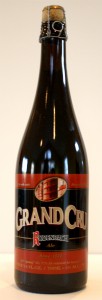 The new year generally brings lots of parties and celebrations, and this year was no exception. While others sip on champagne, however, I prefer to grab a bunch of complex beers and enlighten people to the wide world of brewing. This year, however, led me to discover a new favorite, the Rodenbach Grand Cru.
The new year generally brings lots of parties and celebrations, and this year was no exception. While others sip on champagne, however, I prefer to grab a bunch of complex beers and enlighten people to the wide world of brewing. This year, however, led me to discover a new favorite, the Rodenbach Grand Cru.
Rodenbach started as the family label of the four Rodenbach brothers, who established the brewery in 1821. Three of the brothers’ shares were bought out a few years later by Pedro Rodenbach and his wife, who passed the brewery to their son Eugene in 1878. Eugene traveled to England before taking over to learn how to age beers properly, especially the mixing of different ages of beer to produce the optimum beverage. The brewery was owned by the descendants of the Rodenbachs until 1998, when it was purchased by Palm Breweries. Palm has begun to change the operations at the brewery, but as of now it still produces the barrel-aged beer for which Rodenbach is famous.
The style of beer pioneered by the Rodenbachs is known as the Flanders red ale. The key to this beer is the oak barrels that were traditionally used to age it. The barrels naturally contain some bacteria, such as Pediococcus and Lactobacillus, which slowly eat any sugars left over from the brewing process. These bacteria produce lactic acid, producing a very tart, sour taste. The sour character is frequently enhanced by the introduction of Brettanomyces, a yeast strain that also slowly consumes residual sugars, but in this case produces acetic acid and a number of other sensory compounds. This combination of souring agents tends to produce a very dry, intensely sour beer, but one in which the sourness is carried across a broader spectrum of different compounds that provide a very complex profile. These beers are typically served as blended products, such that the sourness of an older beer is balanced by the sweetness from residual sugars in a fresh beer.
The Grand Cru poured a dark brown-red color and quite clear. Two fingers of dark tan head formed, and even though it largely dissipated in the first few minutes, it continued to leave excellent lacing on the glass. The aroma was quite fine, sour with a fruity, almost raspberry nose, but this dissipated quickly. The body was thick with low carbonation but was also very smooth without leaving the lingering sensation of something coating your mouth as many thick-bodied beers do. The biggest flavor in this beer is a massive sourness, although this is counterpointed with a fairly sweet character. I noticed some more raspberry and other tart fruit flavors like cherry, along with the barest hints of chocolate, but no perceptible bitterness at all. The malt character was surprisingly light, at least based on the color, but provided a nice, slightly sweet base for the sour character.
I tried this beer with a slice of Gouda but found that it clashed rather fiercely, which I thought was surprising. Aged cheddar also did not pair well, although it lacked the intense clash of the Gouda. I personally think this beer would go very well with good red meat, such as a steak, although I would stay away from barbecued meats as the smokiness would probably not pair well. Sourdough bread would almost certainly go well with this beer, especially toasted, and I’m curious as to how a softer, creamer cheese such as brie would pair with it. I’m hesitant to try anything over the top, such a blue cheese, or anything too neutral, such as chicken, although it would make a great marinade for poultry. This type of beer is normally served in a tulip, and many higher-end Belgian bars will actually have Rodenbach-branded glassware on hand as this is the prototypical beer of the style.
I thoroughly enjoyed this beer and highly recommend it to people looking to broaden their palate, or for people who really like red wine. While by no means a wine, this beer is similarly complex and contains enough similar tastes that it may prove palatable to someone open to the new experience. Bud, Miller and Coors drinkers beware, however, as this beer is intense and about as unlike a light lager as you will find.

